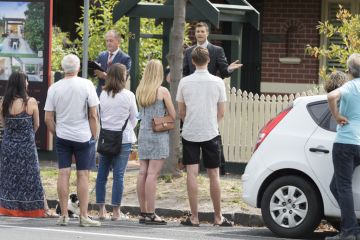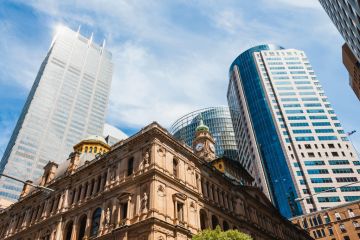Dream home for a shilling
For a good part of 1942, everyone in Mosman was talking about the new house on the hill in Spit Road. A two-storey place with a pillared pergola and french windows, it had a sweeping view across Middle Harbour.
It cost £5000 to build on the £875 block of land but was up for grabs for the cost of a one-shilling raffle ticket.
People all over Australia hoped to win the major prize in the Dream Home raffle, run by the Australian Women’s Weekly to raise money for the Red Cross.
For runners-up, there were lesser prizes – a doll donated by Shirley Temple and a set of boxing gloves from Mickey Rooney – but the house, designed by Ernest Scott of Green and Scott Architects, was the real attraction.
A million tickets were sold, raising £50,000 for care packages to be sent to Australian prisoners of war.
For many, the competition was a welcome distraction during difficult times. In May that year, Japanese midget submarines invaded Port Jackson. The historian and former Herald journalist, Gavin Souter, described the war’s impact on the area in his book Mosman: A History.
”Hire boats were removed from the Spit and taken upstream out of invaders’ way,” he wrote. ”Air-raid trenches were dug for the travelling public at the Spit, Musgrave Street wharf and Reid Park.
Some residents built concrete shelters in their own gardens and others went so far as to remove their entire households to safer locations, particularly in the Blue Mountains. Some sold their homes at bargain prices in order to get away.”
At Mosman’s local school, the playground was dug up to make room for an air-raid shelter. Brian Leckey, now 79 and living in Belrose, remembers playing marbles on the shelter’s sloping roof.
At home, his parents often discussed the Dream Home over dinner.
”I wasn’t that interested,” he says. ”I was probably busy playing planes in the corner but families were talking about this thing. It was a revolutionary design. It had anything anybody could dream about in a home; it had an indoor toilet and it had a refrigerator. At our place, we only had an ice chest.”
Black-and-white photographs in a brochure of plans and specifications show a spacious entry hall with a curved staircase. Candelabra dangled from the ceilings. In the laundry was a brand-new copper for washing clothes.
The Women’s Weekly editor, Alice Jackson, fanned the hype with a cover story. ”This home is, in its building, an architect’s dream home,” she wrote. ”In its interior decorating and furnishing, an artist’s dream home, in its labour-saving equipment, a busy mother’s dream home.”
There were, Jackson said, American socialites and British aristocrats interested in the house but the magazine and the Red Cross preferred it ”be won by an Australian woman and lived in by an Australian family”.
The prize eventually went to a widowed grandmother from Darlinghurst, Maude Bartlett. With her children scattered throughout the world, she had no need for such a large home and sold it four months later for just £3500.
These days, similar houses in the area sell for between $2 million and $3 million, says the principal at Belle Property Mosman, Tim Foote. The house still stands and Australian Property Monitors records show it was passed in at auction for $392,000 on November 26, 1995. But it sold for $425,000 on December 1 of that year.
Living the dream
Shielded from Spit Road’s traffic by a tall brush fence, across from Dream House Lane, the house’s once red door has been painted a dark grey. A basketball hoop is affixed to the original garage. It is a family home where the owners, who wish to remain anonymous, live with their two children, aged 17 and 21.
”We had been looking around the market at the time when this was put up for auction,” the owner says. ”I did some research and found out that it was once on the front cover of the Women’s Weekly.”
After the family moved in, they realised the house loomed large in Mosman’s memory. ”We had people come and knock on the door and ask if this was the Dream House,” the owner says. ”I was told once that some of the older locals have referred to the parties held here.”
He is repainting the kitchen but has kept the house largely as he found it. When the family moved in he removed the original window shutters, which were looking somewhat worse for wear. ”Someone had painted them a mission-brown colour – probably in the ’70s. They were more of an eyesore than anything. I guess that took away a little of the Georgian appeal. The only modification I’m aware of is that the pergola effect is gone. A balcony has been built instead.”
Mosman heritage
As a historically and socially significant building, the house is eligible for Mosman Council’s Heritage Fund, which offers grants of up to $3000 to help with maintenance work or to reinstate original features. It came close to demolition in the ’60s, when the council discussed eliminating the bends in Spit Road and adding two extra lanes. A desire to preserve the house contributed to the proposal’s rejection.
The current owners have not done much research on previous owners but believe it was once home to a Greek family with seven children. The original winner, Mrs Bartlett, sold it to a public accountant and member of the Legislative Council, Arthur Bridges. Subsequent owners have included a solicitor and two company directors.
The current owner plans to stay put for the forseeable future.
”From upstairs, I can look out over Middle Harbour and the yacht club,” he says. ”Friends of ours remark upon the view and the staircase … we have no plans to move.”
Free and easy
For most people, buying a house means careful planning and budgeting. For a lucky few, houses come as windfalls in competitions.
Boystown lottery
Linda and Peter Wisby have just moved into their Buderim home on the Sunshine Coast after winning the $1.5 million property in March.
The couple’s win came at a particularly good time as Peter, an IT worker, had recently been told he may soon lose his job after 40 years with the same company.
”The good news is winning the home means we won’t need to worry so much about our future now,” Linda says.
The charity conducts 10 such lotteries every year, with the proceeds going to BoysTown’s charitable services to help disadvantaged children, young people and families in need. BoysTown gave away its first house in a 1984 lottery, whereby a $5 ticket gave the winner a choice between a luxurious Gold Coast house or a beachfront apartment.
One prize house in Balmain, won by a NSW couple in 2000, rose in value from $770,000 to $1,575,000 in 10 years. The next Sydney house on offer, a semi-detached, three-bedroom cottage at 5 Clayton Street, Balmain, is open for ticket sales and viewing from September 28.
The total prize package is valued at $1,317,443. The draw closes on November 9.
For details see boystown.com.au.
The hothouse
Hailed as the biggest programming disaster of 2004, the reality television show The Hot House involved 14 couples competing to build a $2 million seaside mansion on Bribie Island, near Brisbane.
It was a ratings flop for Channel Ten but a boon for the winners, Jules and Simon Rees, who were awarded the three-bedroom, two-pool house, along with two cars and a boat.
The rules of the game demanded the family live in the house for at least two years.
RSL Art Union Lottery
For almost 55 years, the RSL Art Union has helped support Australia’s veteran community. The lottery tickets for the prize waterfront houses help provide care, welfare and advocacy services.
A brochure about the first lottery in 1953 advertised a block of three units valued at £17,500. Tickets were 10 shillings each.
In August this year, Tracey Bauer won three units: one on the Gold Coast, another in Brisbane and a third on the Sunshine Coast. The current lottery house is a $1.6 million waterfront property at 62 River Links Boulevard East, at Helensvale on the Gold Coast. The draw closes on October 4.
See rslartunion.com.au.
Endeavour prize homes
Since the first Endeavour Prize Homes lottery in 1966, the foundation has given away more than 300 houses. Among the earliest prizes was a $57,000 package including a 1018-hectare property at Wandoan, a small town in Queensland.
In 2000, one $789,000 prize package included a house at Mt Cotton, near Brisbane, $50,000 in gold, a car, a $30,000 diamond ring and a $5000 holiday package. The current lottery house is at 96 Marina Boulevard, Bribie Island. The funds raised help the foundation support people with disabilities.
See www.endeavourprizehomes.com.au.
We recommend
We thought you might like
States
Capital Cities
Capital Cities - Rentals
Popular Areas
Allhomes
More







